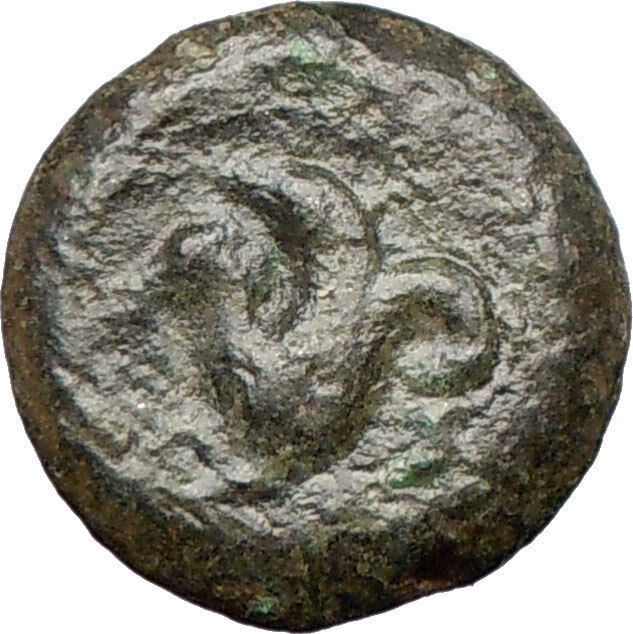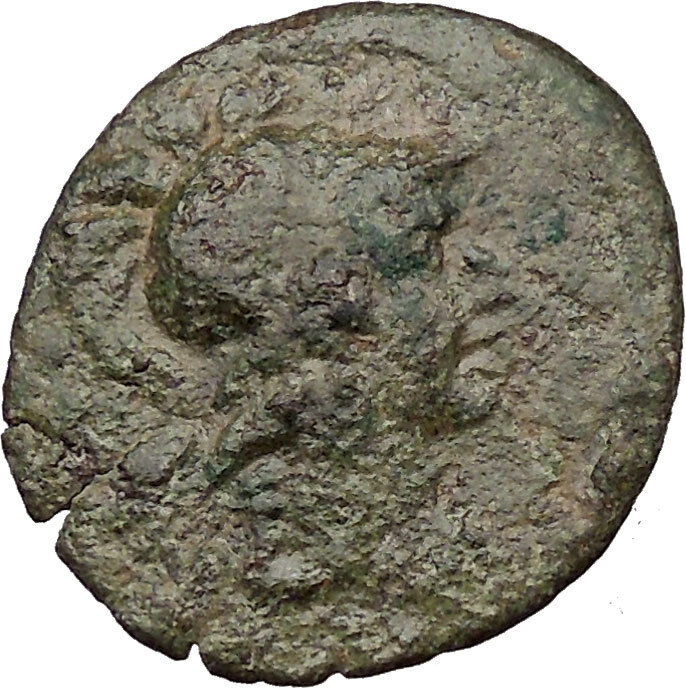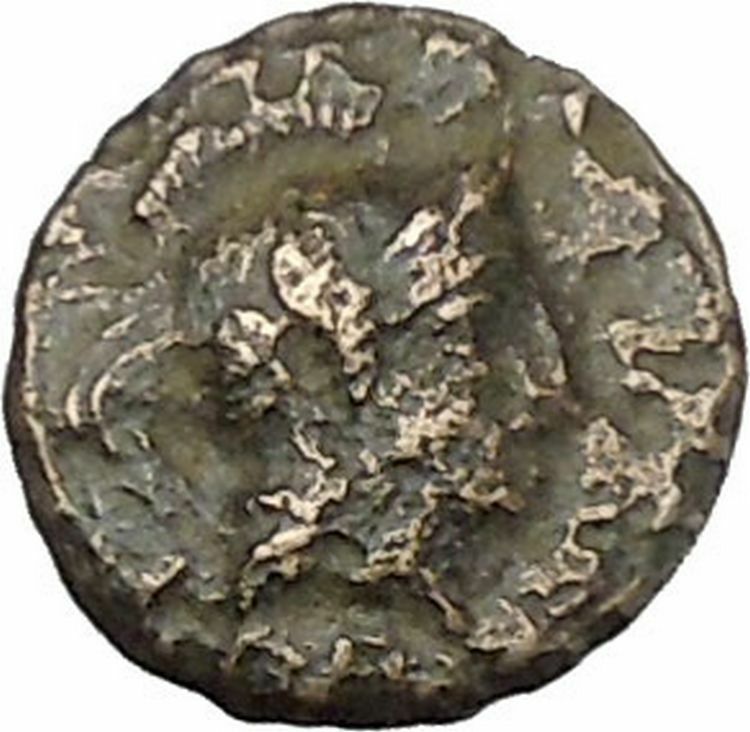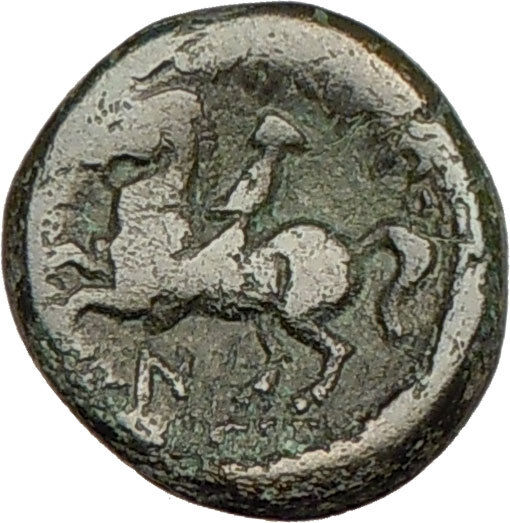|
Alexander III the Great
:
Macedonian
Greek
King: 336-323 B.C.
Pseudo-Autonomous Issue under the Romans
Bronze 24mm (8.36 grams) from the Koinon of Macedonia in Thrace
Struck circa 200-300 A.D.
Reference: Cf. SNG Copenhagen 1367-8
Pedigree: Ex-BCD Collection with his original hand-written tag
AΛЄΞANΔPOV, Head of Alexander the Great right as Hercules
wearing lion-skin headdress.
KOINON MAKЄΔONΩN NEΩKO, Two Agonistic (Olympic-style
athletic games) prize-urns on top of a three dimensional prize table.
* Numismatic Note: Amazing coin being issued over 500 years
after the death of Alexander the Great, featuring his portrait. Alexander the
Great was and still is a great hero of antiquity showing the amazing effect one
man can have on history in just short while of just 13 years! Macedonia
was a province under the control of the Romans, which was created out of the
kingdom of Macedonia which Alexander the Great was king of. Interesting to note
that this being a pseudo-autonomous issue featuring Alexander the Great instead
of the Roman emperor of the time.
This coin also celebrates the neocorate status of the
province, meaning they were important to the imperial cult of the emperor.
The Agonistic games were Olympic-type athletic contests that
were held in the ancient world, one for every year, the most famous games being
the Olympic held at Olympia.
Koinon (Greek: Κοινόν, pl. Κοινά,
Koina), meaning “common” and interpreted as “commonwealth”, “league” or
“federation” were a number of associations of cities in ancient and early modern
Greek history.
You are bidding on the exact
item pictured, provided with a Certificate of Authenticity and Lifetime
Guarantee of Authenticity.
Panhellenic Games is the collective term for four separate
sports festivals held in
ancient Greece
. The four Games were:
| Games |
God Honored |
Location |
Prize |
Frequency |
|
Olympic Games
|
Zeus
|
Olympia
,
Elis
|
Olive wreath (Kotinos) |
Every 4 years |
|
Pythian Games
|
Apollo
|
Delphi
|
Laurel wreath
|
Every 4 years (2 years after the
Olympic Games
) |
|
Nemean Games
|
Zeus
,
Heracles
|
Nemea
,
Corinthia
|
Wild celery
|
Every 2 years (2nd and 4th year of Olympiads) |
|
Isthmian Games
|
Poseidon
|
Isthmia
,
Sicyon
|
Pine
|
Every 2 years |
Description
The Olympiad
was one of the ways the Greeks
measured time. The Olympic Games were used as a starting point, year one of the
cycle; the Nemean and Isthmian Games were both held (in different months) in
year two, followed by the Pythian Games in year three, and then the Nemean and
Isthmian Games again in year four. The cycle then repeated itself with the
Olympic Games. They were structured this way so that individual athletes could
participate in all of the games.
(But note that the dial on the Antikythera mechanism – – seems to show
that the Nemean and Isthmian Games did not occur in the same years.)
Participants could come from all over the Greek world, including the various
Greek colonies
from
Asia Minor
to
Spain
. However, participants probably had to be
fairly wealthy in order to pay for training, transportation, lodging, and other
expenses. Neither women nor non-Greeks were allowed to participate, except for
very occasional later exceptions, such as the Roman emperor
Nero.
The main events at each of the games were
chariot racing
,
wrestling
,
boxing
,
pankration
,
stadion
and various other foot races, and
the pentathlon
(made up of wrestling, stadion,
long jump
,
javelin throw
, and
discus throw
). Except for the chariot race, all
the events were performed nude.
The Olympic Games were the oldest of the four, said to have begun in 776 BCE.
It is more likely though that they were founded sometime in the late 7th century
BCE. The Pythian, Nemean and Isthmian games most likely began sometime in the
first or second quarter of the 6th century BCE. The Isthmian games were held at
the
temple to Poseidon
on the
Isthmus of Corinth
.
The games are also known as the stephanitic games, because winners received
only a garland
for victory. (Stephanitic derives from
stephanos the
Attic Greek
word for crown.) No financial or
material prizes were awarded, unlike at other Ancient Greek athletic or artistic
contests, such as the
Panathenaic Games
, at which winners were
awarded many amphorae
of first-class Athenian olive-oil. The
Olympic games awarded a garland of
olives
; the Pythian games, a garland of
laurel
, i.e.
bay leaves
; the Nemean games, a crown of
wild celery
, and the Isthmian, a garland of
pine leaves in the
archaic period
, one of dried celery in the
Classical
and
Hellenistic
periods, and again one of pine from
then on. Though victors received no material awards at the games, they were
often showered with gifts and honors on returning to their
polis
.
See also
-
Panathenaic Games
- Agonothetes
- Theorodokoi
- Theoroi
Hercules is the Roman name for the Greek
divine
hero Heracles
, who was the son of
Zeus (Roman equivalent
Jupiter
) and the mortal
Alcmene
. In
classical mythology
, Hercules is famous for his
strength and for his numerous far-ranging adventures.

The
Romans adapted the Greek hero’s iconography and myths for their literature and
art under the name Hercules. In later
Western art
and literature and in
popular culture
, Hercules is more
commonly used than Heracles as the name of the hero. Hercules was a
multifaceted figure with contradictory characteristics, which enabled later
artists and writers to pick and choose how to represent him. This article
provides an introduction to representations of Hercules in the
later tradition
.
Labors of Hercules
Hercules is known for his many adventures, which took him to the far reaches
of the
Greco-Roman world
. One cycle of these
adventures became
canonical
as the “Twelve Labours,” but the list
has variations. One traditional order of the labours is found in the
Bibliotheca
as follows:
- Slay the
Nemean Lion
.
- Slay the nine-headed
Lernaean Hydra
.
- Capture the
Golden Hind of Artemis
.
- Capture the
Erymanthian Boar
.
- Clean the Augean
stables in a single day.
- Slay the
Stymphalian Birds
.
- Capture the
Cretan Bull
.
- Steal the
Mares of Diomedes
.
- Obtain the girdle of
Hippolyta
, Queen of the
Amazons
.
- Obtain the cattle of the monster
Geryon
.
- Steal the apples of the
Hesperides
.
- Capture and bring back
Cerberus
.
The Latin
name Hercules was borrowed through
Etruscan
, where it is represented variously as
Heracle
, Hercle, and other forms. Hercules was
a favorite subject for
Etruscan art
, and appears often on
bronze mirrors
. The Etruscan form Herceler
derives from the Greek Heracles via
syncope
. A mild oath invoking Hercules (Hercule!
or Mehercle!) was a common
interjection
in
Classical Latin
.

Baby Hercules strangling a
snake
sent to
kill him in his
cradle
(Roman marble, 2nd century CE)
Hercules had a number of
myths
that were distinctly Roman. One of these
is Hercules’ defeat of
Cacus
, who was terrorizing the countryside of
Rome. The hero was associated with the
Aventine Hill
through his son
Aventinus
.
Mark Antony
considered him a personal patron
god, as did the emperor
Commodus
. Hercules received various forms of
religious veneration
, including as a
deity concerned with children and childbirth
,
in part because of myths about his precocious infancy, and in part because he
fathered countless children. Roman brides wore a special belt tied with the “knot
of Hercules“, which was supposed to be hard to untie. The comic
playwright Plautus
presents the myth of Hercules’
conception as a sex comedy in his play
Amphitryon
;
Seneca
wrote the tragedy Hercules Furens
about his bout with madness. During the
Roman Imperial era
, Hercules was worshipped
locally from Hispania
through
Gaul.
Medieval mythography
After the Roman Empire became
Christianized
, mythological narratives were
often reinterpreted as
allegory
, influenced by the philosophy of
late antiquity
. In the 4th century,
Servius
had described Hercules’ return from the
underworld as representing his ability to overcome earthly desires and vices, or
the earth itself as a consumer of bodies. In medieval mythography, Hercules was
one of the heroes seen as a strong role model who demonstrated both valor and
wisdom, with the monsters he battles as moral obstacles. One
glossator
noted that when
Hercules became a constellation
, he showed that
strength was necessary to gain entrance to Heaven.
Medieval mythography was written almost entirely in Latin, and original Greek
texts were little used as sources for Hercules’ myths.
Renaissance
mythography
The Renaissance
and the invention of the
printing press
brought a renewed interest in
and publication of Greek literature. Renaissance mythography drew more
extensively on the Greek tradition of Heracles, typically under the Romanized
name Hercules, or the alternate name
Alcides
. In a chapter of his book
Mythologiae (1567), the influential mythographer
Natale Conti
collected and summarized an
extensive range of myths concerning the birth, adventures, and death of the hero
under his Roman name Hercules. Conti begins his lengthy chapter on Hercules with
an overview description that continues the moralizing impulse of the Middle
Ages:
Hercules, who subdued and destroyed monsters, bandits, and criminals, was
justly famous and renowned for his great courage. His great and glorious
reputation was worldwide, and so firmly entrenched that he’ll always be
remembered. In fact the ancients honored him with his own temples, altars,
ceremonies, and priests. But it was his wisdom and great soul that earned
those honors; noble blood, physical strength, and political power just
aren’t good enough.
Neocorate
Status of a City, an Honor Bestowed
by the
Emperor
– Neocorus is the Greek name for
the person that was in charge of taking care of a temple. The Roman had many
Greek cities under their control and taxation. So what these cities had was a
cult of worship of the emperor and the empire, so this name was then given to
the specific cities that maintained this cult worship. Getting this status, was
meant to show allegiance to the emperor and the empire. The cities has to earn
the status from the emperor to bestow it upon them. There may have been
additional benefits associated with this status also. The cities were very
honored to announce the status on their coins, bearing the Greek NEΩKOPΩN on
them. There were many times that neocorate status was award many times, so
subsequent statuses would be signaled with various Greek letters, preceding the
NEΩKOPΩN inscription such as B,Δ,Γ. A city
which got this status, would have agonistic, or (Olympic-type) athletic contest
type games and festivals. So there are many coins that depict agonistic imagery
on them struck in honor of these events. Not many people in ancient numismatics
understand or know about the significance of these honors bestowed on a city.
This furnishes a great record for study to unravel the mysteries of the ancient
past and a connection between the government of the city and the various gods
and goddesses depicted on them.
Alexander III of Macedon, popularly known to history as Alexander
the Great,
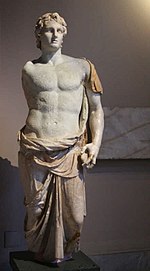
(“Mégas Aléxandros“)
was an
Ancient Greek
king (basileus)
of
Macedon
. Born in 356 BC, Alexander succeeded his father
Philip II of Macedon
to the throne in 336 BC, and died in
Bablyon
in 323 BC at the age of 32.
Alexander was one of the most successful military commanders of all time and
it is presumed that he was undefeated in battle. By the time of his death, he
had conquered the
Achaemenid Persian Empire
, adding it to Macedon’s European territories;
according to some modern writers, this was much of the world then known to the
ancient Greeks (the ‘Ecumene‘).
His father, Philip, had unified most of the
city-states
of mainland Greece under Macedonian
hegemony
in
the
League of Corinth
. As well as inheriting hegemony over the Greeks, Alexander
also inherited the Greeks’ long-running feud with the
Achaemenid Empire
of
Persia
. After reconfirming Macedonian rule by quashing a rebellion of
southern Greek city-states, Alexander launched a short but successful campaign
against Macedon’s northern neighbours. He was then able to turn his attention
towards the east and the Persians. In a
series of campaigns
lasting 10 years, Alexander’s armies repeatedly defeated
the Persians in battle, in the process conquering the entirety of the Empire. He
then, following his desire to reach the ‘ends of the world and the Great Outer
Sea’, invaded India, but was eventually forced to turn back by the near-mutiny
of his troops.
Alexander died after twelve years of constant military campaigning, possibly
a result of malaria
, poisoning
,
typhoid fever
, viral
encephalitis
or the consequences of alcoholism. His legacy and conquests
lived on long after him and ushered in centuries of Greek settlement and
cultural influence over distant areas. This period is known as the
Hellenistic period
, which featured a combination of
Greek
,
Middle
Eastern
and
Indian culture
. Alexander himself featured prominently in the history and
myth of both Greek and non-Greek cultures. His exploits inspired a literary
tradition in which he appeared as a legendary
hero in the
tradition of Achilles
.

Alexander fighting Persian king Darius III. From Alexander
Mosaic, from Pompeii, Naples, Naples National
|









